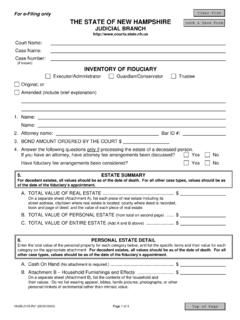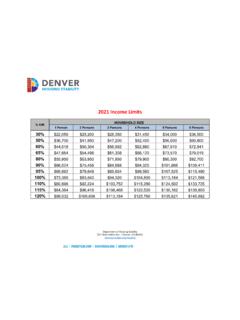Transcription of Draft Program Guidelines Low Income Household Water ...
1 Draft . Program Guidelines . Low Income Household Water Assistance Program (LIHWAP). February 16, 2022. CALIFORNIA DEPARTMENT OF. COMMUNITY SERVICES AND DEVELOPMENT. CONTENTS. I. 1. II. Program DESCRIPTION AND OVERVIEW .. 4. III. LIHWAP LOCAL ADMINISTRATOR DESIGNATION .. 6. IV. 7. V. SERVICE DELIVERY MODEL .. 9. VI. Household ELIGIBILITY .. 9. VII. BENEFIT PAYMENT & ISSUANCE .. 10. VIII. COORDINATION .. 11. IX. STATE AND FEDERAL REPORTING REQUIREMENTS .. 11. X. MONITORING AND QUALITY ASSURANCE .. 12. I. INTRODUCTION. The California Department of Community Services and Development (CSD) developed the following Program Guidelines for the federal Low Income Household Water Assistance Program (LIHWAP) Fiscal Year (FY) 2022-24, offering a Program design framework for a one-time federally funded relief Program providing financial assistance to low- Income households to reduce Water and wastewater arrearages prior to and during the COVID-19. pandemic. On December 27, 2020, the Consolidated Appropriations Act was signed into law and appropriated $638 million to LIHWAP.
2 Additionally, on March 11, 2021, the American Rescue Plan Act appropriated $500 million to LIHWAP. LIHWAP is administered at the federal level by the Department of Health and Human Services (HHS). CSD was named by Governor Gavin Newsom as the designated agency to administer LIHWAP for the State of California. HHS approved California's LIHWAP State Plan on November 8, 2021. CSD has been serving low- Income communities for more than 50 years. A state department under the California Health and Human Services Agency, CSD has traditionally partnered with a network of non-profit and local government organizations (commonly referred to as Local Service Providers [LSPs]) dedicated to reducing poverty by helping low- Income individuals and families achieve and maintain economic security, meet their home energy needs, and reduce their utility costs through energy efficiency upgrades and access to clean renewable energy. CSD Low Income Household Water Assistance Program (LIHWAP) Draft Program Guidelines FY 2022-24.
3 Page 1. In addition to LIHWAP, CSD administers the following federal programs intended to reduce poverty and improve the lives of low- Income Californians: Department of Health & Human Services Community Services Block Grant (CSBG). Department of Health & Human Services Low- Income Home Energy Assistance Program (LIHEAP). Department of Energy Weatherization Assistance Program (DOE WAP). Consistent with federal guidance provided by HHS, LIHWAP Program Guidelines are modeled on existing LIHEAP procedures, systems, and practices. These Guidelines also reflect stakeholder input received during the LIHWAP State Plan meeting and Program Guideline development process. LIHWAP Program Guidelines are prepared in accordance with LIHWAP Grant General Terms and Conditions, Program -Specific Terms and Conditions and Policy Guidance established by HHS. The Program Guidelines serve as a companion document to the LIHWAP State Plan. As any changes are made to the Program Guidelines based on stakeholder feedback or to address unforeseen developments identified during the course of Program administration, CSD will work to ensure that both the State Plan and Program Guidelines are updated and consistent with each other.
4 All Program subgrantees must adhere to Program Guidelines as established and as amended throughout the life of the Program . STATE Program NEED. California is the nation's most populous state, with nearly 40 million residents. Close to one- third of the population lives in households with incomes below $50,000 a year, or approximately 200 percent of the federal poverty level for a family of four. The state has roughly 2,900 community Water systems that serve 98 percent of the population; over 2,400. of these systems have fewer than 3,000 service connections and serve communities with fewer than 15,000 residents. The other two percent of the population is served by small systems with fewer than 15 service connections or private wells. In addition to community Water systems, there are over 125 major wastewater treatment providers in California, as well as numerous smaller wastewater treatment providers. The cost of drinking Water and wastewater treatment can vary widely across the state, and variance in rates is mainly attributable to factors such as quality of Water sources, treatment needs, economies of scale, historical system maintenance, and capital investment.
5 In both urban and rural communities, financially challenged households struggle to pay Water and wastewater bills. Data collected in 2019 by the State Water Resources Control Board (SWRCB) show that at least 500,000 Californians experienced Water shutoffs due to nonpayment and hundreds of Water providers charge rates that could be classified as unaffordable for low- Income households. Californians similarly face challenges with arrearages accumulated for wastewater services. Feedback from wastewater providers indicates substantial COVID-related arrearage debt for wastewater. While exact numbers are not available, it is estimated COVID-related wastewater arrearages across the state may total several hundred million dollars. This is CSD Low Income Household Water Assistance Program (LIHWAP) Draft Program Guidelines FY 2022-24. Page 2. consistent with what other utilities have reported about a significant increase in customers being financially impacted during the pandemic, resulting in higher than usual customer debt for that period.
6 California's high cost of living, especially in urban areas, means financially challenged households are often forced to choose between paying for different basic living expenses, including housing, food, healthcare, and utilities. As these particular households navigate the economic impacts of the pandemic, support is needed to help families at risk of losing access to essential residential Water and wastewater services. To address the overwhelming need for financial assistance, the 2021-22 State Budget appropriated $1 billion in federal American Rescue Plan Act funding to establish the California Water and Wastewater Arrearage Payment Program (CWWAPP), providing relief to community Water and wastewater systems for unpaid bills related to the pandemic that accrued during the pandemic relief period from March 4, 2020 to June 15, 2021. The SWRCB is the designated state administrator of CWWAPP. In a survey conducted in 2021, the SWRCB identified a total of $276,583,036 in residential drinking Water arrearages accrued and $42,817,626 in commercial arrearages during the COVID-19 pandemic bill relief period as reported by 2,293 community Water systems participating in the survey (SWRCB 2021 Drinking Water Arrearage Survey Results).
7 To facilitate the issuance of CWWAPP to community Water systems, SWRCB received applications for funding from 665 community Water systems and disbursed approximately $301 million in CWWAPP funds to community Water systems, which is expected to fully address the drinking Water arrearage debt for their customers accrued during the pandemic relief period. While this level of assistance is substantial, the assistance itself is not specifically targeted to low- Income households and does not address the Water debt many customers continue to accrue beyond June 15, 2021, or after the pandemic relief period. Also, while Water systems accounting for about 80 percent of the state's population participated in the CWWAPP, some systems did not, and customers with arrearages in those systems did not receive relief assistance. The SWRCB is currently implementing the second phase of CWWAPP to provide wastewater arrearage debt relief to customers of participating wastewater treatment providers that apply for funding.
8 The SWRCB did not conduct a survey to estimate accrued residential wastewater arrearages during the COVID-19 pandemic bill relief period. However, as stated earlier, COVID-related wastewater arrearages across the state are estimated to be several hundred million dollars. The federal funding provided under LIHWAP will serve as complimentary Program resource to CWWAPP by offering another form of potential assistance to low- Income households continuing to experience difficulty making payments for residential Water and wastewater services. CSD Low Income Household Water Assistance Program (LIHWAP) Draft Program Guidelines FY 2022-24. Page 3. II. Program DESCRIPTION AND OVERVIEW. A. OVERVIEW. LIHWAP is a one-time, federally funded relief Program that provides financial assistance to low- Income households who have struggled to make Water and/or wastewater payments prior to, and during the COVID-19 pandemic. Key federal requirements and principles informing the Program design framework for LIHWAP include: LIHWAP funds shall be used as part of an overall emergency effort to prevent, prepare for, and respond to the coronavirus, with the public health focus of ensuring that low- Income households have access to safe and clean drinking Water and wastewater services.
9 LIHWAP funds shall be used to reduce arrearages and/or rates charged to low- Income households. HHS prioritizes the use of funds to first address arrearages, with addressing rates (defined as paying current bills) as the last priority. LIHWAP benefits shall be paid directly to owners and operators of public Water systems. LIHWAP is to be modeled after existing processes, procedures, and policies currently in place to provide assistance to low- Income households such as LIHEAP, where practical. In accordance with California Government Code Section , the State of California has prioritized LIHWAP services that reduce arrearages and establishes regular reporting to the Legislature to inform of Program implementation and progress with LIHWAP service delivery and grant expenditure. Consistent with federal and state directives for prioritizing the use of LIHWAP funds to Water and wastewater arrearages, CSD has modeled the LIHWAP Program as an arrearage response Program .
10 LIHWAP assistance payments will be used to pay Water and/or wastewater arrearages on a first-come, first-served basis to eligible households. Assistance may be applied to either Water debt or wastewater debt (or both when a customer's bill bundles both services and the assistance amount needed to restore or prevent disconnection includes both services) to ensure households maintain access to clean, safe drinking Water and wastewater services. The appropriations language contained in the Consolidated Appropriations Act of 2021. instructs HHS and state grantees to to the extent practicable, use existing processes, procedures, policies, and systems in place to provide assistance to low- Income households. Based on this guidance from HHS, CSD has closely modeled LIHWAP. administration and Program requirements on the LIHEAP Program in order to realize administrative efficiencies and accelerate the rollout of LIHWAP local grant administration at both the state and local level.


